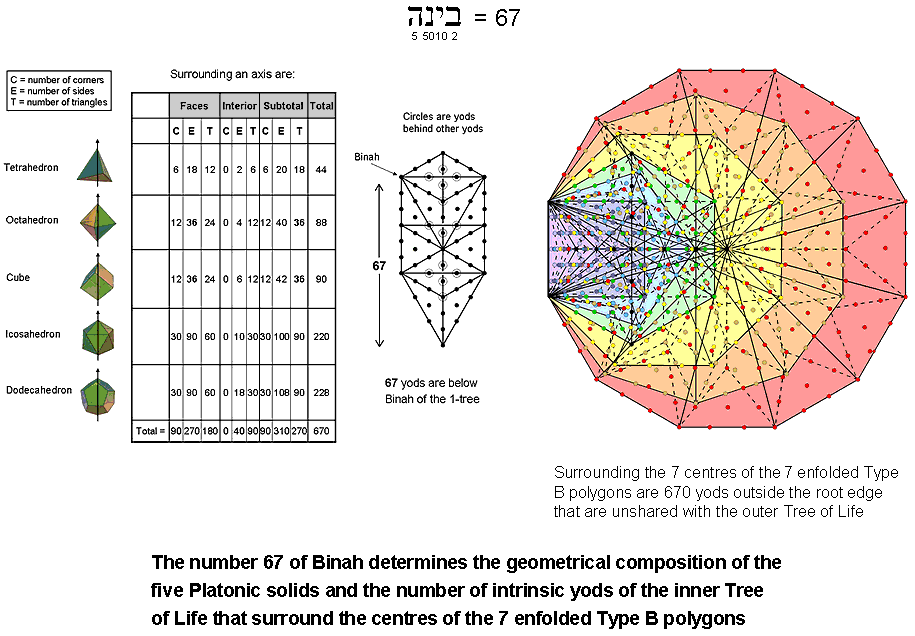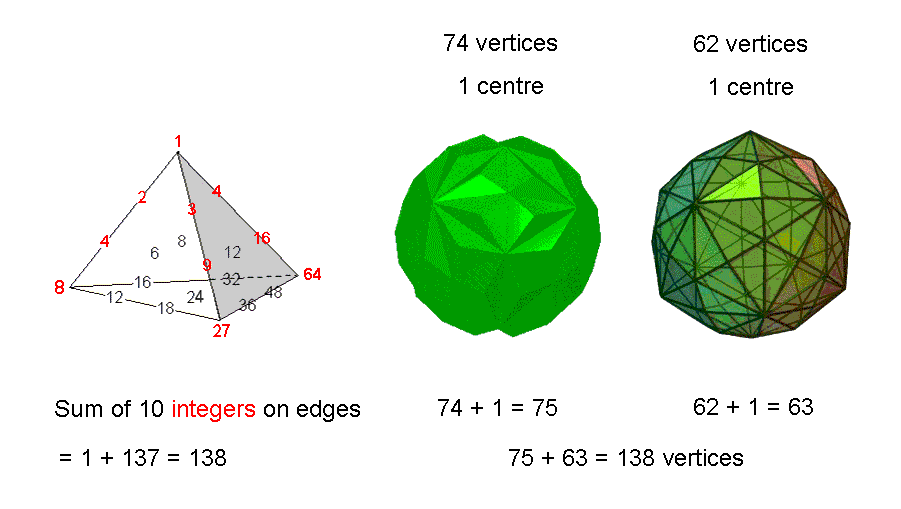
| << Previous 1... 28 29 [30] 31 32 ...39 Next >> |
#30 Sacred geometries embody the number value 67 of Binah

Imagine the 50 faces of the five Platonic solids each divided into their sectors. Then regard their edges as sides of internal triangles with the centre of the polyhedron as a shared corner that is joined to their vertices. According to the table in the picture above, the number of corners, sides & triangles in the faces and interiors of the five Platonic solids that surround their axes passing through two opposite vertices = 670 = 67×10. The number 67 of Binah, the third member of the Supernal Triad, is the average number of geometrical elements surrounding the axis in half a Platonic solid.
When the 19 triangles of the 1-tree (the lowest of any set of overlapping Trees of Life) are tetractyses, it contains 80 yods. The number 80 is the number value of Yesod, the penultimate Sephirah. Below Binah of the 1-tree are 67 yods. There are 73 yods up to (and including) Chokmah of the 1-tree, where 73 is the number value of Chokmah. These amazing properties illustrates the geometrical meaning of the gematria number values of the 10 Sephiroth.
According to the table, 90 points, 310 lines (=31×10) and 270 triangles surround the axes of the five regular polyhedra. 360 (=36×10) points & triangles surround them. This is how the Godname EL of Chesed with number value 31 and the Godname ELOHA of Geburah with number 36 prescribe the geometrical composition of the five Platonic solids constructed from triangles. (310/2=155) lines make up each set of their halves, where 155 is the number value of ADONAI MELEKH, the complete Godname of Malkuth. 400 points & lines surround their axes. On average, 80 points & lines surround the axis of a Platonic solid.
The seven enfolded Type B polygons contain 687 yods.* The seven black yods on the vertical axis of the right-hand hexagon lie on the Pillar of Mercy and are shared with tetractyses belonging to the outer Tree of Life (seven similar yods line the vertical axis of the left-hand hexagon coinciding with the Pillar of Severity). The centre of each enfolded Type B triangle coincides with an hexagonal yod lying on a side of the triangle with Chesed, Geburah & Tiphareth at its corners. Hence, eight black yods belonging to each set of seven enfolded polygons are shared with the outer Tree of Life. This leaves (687−4−8=675) yods in each set of seven enfolded polygons that are outside the root edge and unshared with the outer Tree of Life. They include the five other centres of the polygons. The number of such intrinsic yods that surround the centres of the seven enfolded polygons = 675 − 5 = 670. This is the number of points, lines & triangles in the faces and interiors of the five Platonic solids that surround their axes. Once again, the number of Binah determines the form of the inner Tree of Life through the intrinsic yods surrounding centres of polygons that shape them. It illustrates the meaning of this Sephirah as the source of all archetypes expressing the Divine Form. The five regular polyhedra are the three-dimensional embodiment of these archetypes, realised in a single polyhedron in the shape of the disdyakis triacontahedron — the outer form of the polyhedral Tree of Life (see here).
Each axis of a Platonic solid consists of two points and two lines (i.e., four geometrical elements) surrounding its centre. Including their axes, (5×4 + 670 = 690) points, lines & triangles surround the centres of the five Platonic solids, that is, 138 geometrical elements on average. The dodecagon is the last of the seven types of polygons making up the inner Tree of Life. Constructed from tetractyses, the two Type A dodecagons have 138 yods outside their root edge. Ten of the 20 integers making up the Tetrahedral Lambda line its slopes (they are coloured red in the diagram below). Their sum is 138. The two polyhedra making up the Polyhedral Tree of Life are the so-called "144 Polyhedron" with 74 vertices, 216 edges & 144 triangular faces and the disdyakis triacontahedron with 62 vertices, 180 edges & 120 triangular faces. Joining their (74+62=136) vertices to their centres creates (144+120+216+180=660) triangles with (136+2=138) corners. The number of geometrical elements needed on average to build a Platonic solid is naturally embodied in other sacred geometries. This should not be surprising, for the same parameters characterize all sacred geometries (see The holistic pattern), although the numbers may quantify different properties.
|
|
 |
|
The two joined, Type A dodecagons that belong to the inner Tree of Life have 138 yods outside their shared root edge. |
The sum of the 10 integers on the sloping edges of the Tetrahedral Lambda is 138. This is the number of points defining the centres and vertices of the two polyhedra constituting the polyhedral Tree of Life. |
* Proof: The (7+7) enfolded, Type B polygons contain 1370 yods (see #3 in this section). (1370/2=685) yods are associated with each set of seven enfolded polygons. The number of yods in either set = 685 + 2 = 687.
| << Previous 1... 28 29 [30] 31 32 ...39 Next >> |